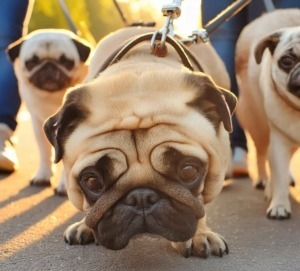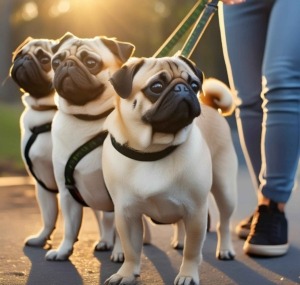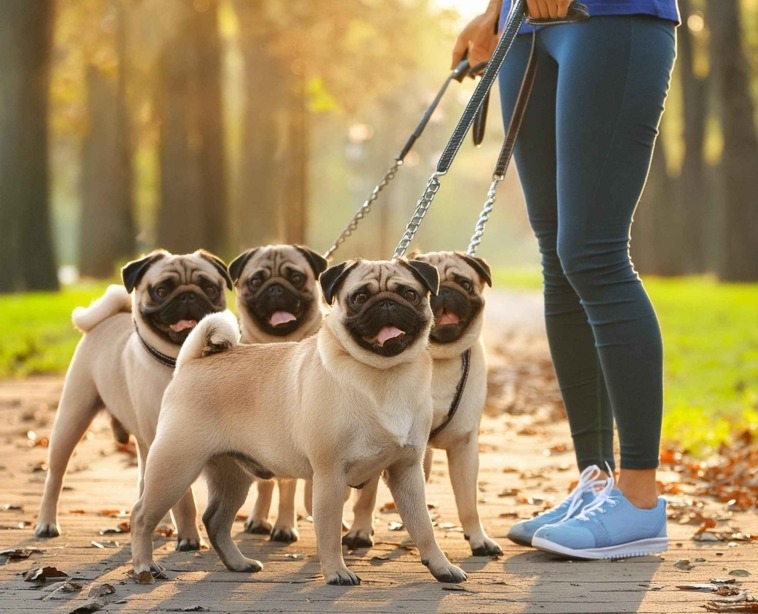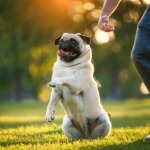Last updated on October 24th, 2024
Here’s an overview:
Understanding your pug’s personality
Choosing the Right Leash and Collar
Positive Reinforcement Techniques
The need for consistency in leash training for pugs
Health and Safety Considerations
Advanced Leash Training for Pugs Tips
Understanding your pug’s personality
Pugs are generally friendly and playful. They thrive on human interaction and often require constant attention from their owners. Understanding how they behave can help make leash training more effective.
- Sociability: Pugs like others both people and other animals, which is why you should socialize them properly before taking them out for walks.
- Stubbornness: They can also be extremely stubborn hence the need to be patient and consistent in teaching them new things.
- Curiosity: Their curious nature may lead them to wander around; get a strong leash as it would come in handy here.
- Anxiety: This may result into separation anxiety. Short frequent walks can help relieve stress in such cases.
Appreciating these attributes guarantees successful training sessions.
Choosing the Right Leash and Collar
Properly selecting a leash and collar is vital for effective leash training.
- Collars: Opt for a comfortable, well-fitting collar due to their short necks with delicate tracheas a harness would work better
- Harnesses: Find harnesses that even out pressure on the chest area while not restricting movement
- Leashes: Go for a regular straight forward one which normally extends 4-6 feet. This range provides control without limiting movement.
- Materials: Ensure that materials used are hardwearing but soft too; nylon or leather coverings are commonly used.
- Safety Features: Reflective strips enhance visibility during evening walks.
- Comfort: Collar and harness padding prevents chafing.
Getting Started Indoors
Begin in a quiet room with few distractions. Let the pug sniff and examine these accessories to introduce them to the leash and collar. Once you have placed the leash on the collar, allow the dog to drag it around as it gets familiar with it.
Steps in leash training for pugs:
Introduce the Leash:
- Lay the leash flat on the floor.
- Encourage your pet to come closer.
Attach the Leash:
- Gradually put the leash onto its neck
- Let your pet move freely
Practice Walking:
- Treat gently while steering him using snacks
- Walk for a few steps before praising her or him
- Be patient and consistent during this first phase.
Building a Routine
Creating a routine is important when it comes to successful leash training. On that note, walking can be built up gradually by setting regular times each day for walks that will make you anticipate and feel comfortable about going out there together with your Pugs more often than not.
- Designate Specific Times: Choose particular times throughout every single day.
- Short, Frequent Sessions: Start with walks of 10-15 minutes.
- Repetition: Regularity reinforces positive behavior.
Establish quiet pre-walk routines which prevent over-excitement from happening. “It is important that you are consistent,” said trainers,

Remember about leash training for pugs:
Hydration breaks especially when it’s hot outside After-walk treats. Progressive inclusion of different surroundings. A consistent schedule reduces anxiety levels thus encouraging good walking habits; therefore, every walk becomes more enjoyable.
Positive Reinforcement Techniques
Positive reinforcement can make Pug leash training fun. Put these tips into practice consistently;
- Treats: Reward them appropriately for walking nicely beside you by giving their favorite treats occasionally while on their leashes; this can be a way of saying “I am happy with you”.
- Praise: Give verbal appreciation and caress them while they are behaving well.
- Clicker Training: Get a clicker that can be used to mark the desired behavior after which it is followed by giving food.
- Consistency: Maintain a consistent training schedule to reinforce positive outcomes.
- Short Sessions: Keep training sessions short and sweet in order for your Pug to remain focused and excited.
This, if combined effectively makes leash training a pug a rewarding and fascinating experience for the dog and its owner.
Challenges Faced in leash training for pugs
- Knowing and addressing common challenges can make pug leash training more successful and fun.
- When the dog pulls
- Consider using a no-pull harness.
- Make sure to reward your puppy for staying beside you when you are walking.
Lunging at distractions
- Keep treats on hand to hold the dog’s attention in such cases.
- Begin with the low distraction environment before exposing them to other sources of noise and movement slowly.
Refusing to walk
- Check that the dog is not uncomfortable in any way due to the collar or being on a leash that it might be sensitive about.
- Help your pet move by using ropes or rewards such as foodstuffs that can easily be moved along with.
Leash biting
- Give your pet toys made of rubber for chewing on instead of biting your equipment.
- Spray some bitter substance onto this item, which tastes bad when chewed, thus discouraging this kind of behavior from happening ever again in future.
Being overexcited
- Firstly conduct short calm sessions with the animal.
- Increase duration gradually until they are able to stay longer without getting agitated or distracted by simple things around them.
Such measures guarantee efficient leash training for dogs above anything else.
The need for consistency in leash training for pugs
- Retractable Leashes: These facilitate pulling and decrease the owner’s control of their dogs. Stick to a standard 4-6 foot leash instead.
- Skipping Warm-ups: Pugs need time to acclimatize themselves. Commence with short gentle strolls before going on long walks.
- Punishment Based Training: Negative reinforcement can cause fear and anxiety in the dog. Reward them for positive behaviour using treats.
- Neglecting Socialization: Isolation can lead to fear-based reactions. Gradually introduce him/her to different environments and people.
- Ignoring Signals: Failure to notice that your pug is uncomfortable or stressed could result in negative associations being formed between it and the leash. Pay attention and take corrective measures where necessary.
Health and Safety Considerations
Pugs are brachycephalic, which means they have short noses that may result in breathing problems. For prevention of neck pressure, choose a harness instead of a collar. Particular attention should be paid to overheating signs, especially when it is hot outside. Ensure all the equipment, like leashes or harnesses, is in sound condition to prevent accidents.
Tips for Safe Walks in leash training for pugs
- Avoid Extreme Temperatures: Take walks during cooler periods.
- Hydration: Carry water for both owner and pug.
- Reflective Gear: Use for evening or early morning walks.
- Check Paws: Inspect any injuries or foreign objects stuck on your pug’s paws.
Common Health Signs to Monitor
- Heavy panting
- Lethargy
- Excessive drooling
Consult a veterinarian for individualized advice at all times.
Advanced Leash Training for Pugs Tips
Advance leash training for pugs incorporates techniques that enhance their walking experience.
- Utilize Clicker Training: Associate clickers with treats as a way of reinforcing good behavior.
- Incorporate Directional Changes: Regularly change directions walked so as to promote attentiveness.
- Practice Loose Leash Walking: Reward the pug when the leash remains loose so as to dissuade pulling activities.
- Introduce Heel Command: Teach the dog how to walk beside you without going astray.
- Use Distractions: Gradually introduce distractions and practice commands in order to maintain focus.

Implement Consistent Commands: Avoid words changing or different tones since this can be confusing therefore using similar words and tone helps mitigate confusion with respect to commands given by push owners.
This methodical approach guarantees progress and fun during these outings together with your pet.
Common Mistakes To Avoid
- Inconsistency: failure to follow a steady training schedule may confuse the dog thus ensure consistency in routine development of acceptable behaviors .
- Using A Retractable Leash: They may encourage pulling and limit the owner’s control instead use a regular 4-6 feet leash.
- Skipping Warm-ups: Pugs need time to get accustomed. Start with short, gentle walks before longer outings.
- Punishment Based Training: This strategy may lead to fear and anxiety; it is better to focus on positive reinforcement and treats.
- Neglecting Socialization: Isolation can be so fearful leading to the fear-based reactions once they are exposed. Gradually expose the pug into other environments and people.
- Ignoring Signals: Failure to observe your dog’s distress or tension signals when it has been leashed leads to negative associations. Pay attention and adjust accordingly.
Content from: Abdullah (Senior Trainor)




